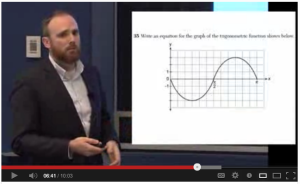Here is another installment in my series reviewing the NY State Regents exams in mathematics.
Consider the following problem from the January 2013 Algebra 2 / Trigonometry exam:
What’s interesting about this problem is what it doesn’t tell you.
The student here is expected to assume that the terms in the sequence keep going up by 9. That is, the student is expected to assume that the sequence is arithmetic. Once the student makes that assumption, they can use the appropriate formula to sum the first 20 terms.
Encouraging students to assume that arbitrary sequences are arithmetic is bad practice. It can develop in students a sense that sequences are usually arithmetic, which will make it harder for them to understand non-arithmetic sequences later on.
More generally, we don’t want students getting into the habit of making unconscious assumptions about problems. By forcing them to make assumptions that fit the problem to the test, questions like this train students not to ask questions like “Are we sure the next term is 50? What else might it be?”. This was one of the main points of my talk “g = 4, and Other Lies the Test Told Me“.
It’s not outrageous that think that this sequence might be arithmetic. But the mathematical world is a rich and complex place. Are we really sure that this sequence is arithmetic? After all, maybe what we’re really looking at is the sequence of numbers whose digits add to five!
Am I thinking too deeply about this sequence? Maybe. But as a teacher, thinking deeply about mathematics is precisely what I want my students to do.

